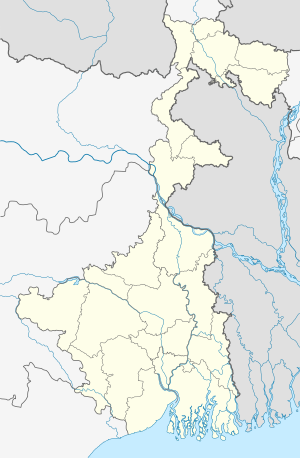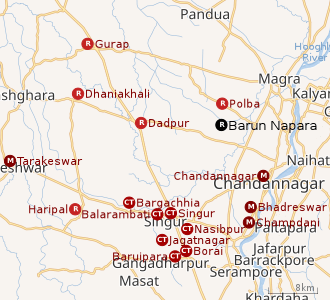Barun Napara
Barun Napara is a village in Polba Dadpur CD Block in Chinsurah subdivision of Hooghly district in the state of West Bengal, India.
Barun Napara | |
|---|---|
Village | |
 Barun Napara Location in West Bengal, India  Barun Napara Barun Napara (India) | |
| Coordinates: 22.9345°N 88.3026°E | |
| Country | |
| State | West Bengal |
| District | Hooghly |
| Elevation | 15 m (49 ft) |
| Population (2011) | |
| • Total | 1,628 |
| Languages | |
| • Official | Bengali, English |
| Time zone | UTC+5:30 (IST) |
| PIN | 712514 (Polba) |
| Telephone/STD code | 03213 |
| Lok Sabha constituency | Hooghly |
| Vidhan Sabha constituency | Chunchura |
| Website | hooghly |
Geography
 |
| Cities and towns in the Chandannagore subdivision and Polba Dadpur and Dhaniakhali CD Blocks of Chinsurah subdivision in Hooghly district M: municipal corporation/ municipal city/ town, CT: census town, R: rural/ urban centre, Owing to space constraints in the small map, the actual locations in a larger map may vary slightly |
Location
The area is composed of flat alluvial plains that form a part of the Gangetic Delta.[1]
CD Block HQ
The headquarters of Polba Dadpur CD Block are located at Barun Napara.[2]
Urbanisation
In Chandannagore subdivision 58.52% of the population is rural and the urban population is 41.48%. Chandannagore subdivision has 1 municipal corporation, 3 municipalities and 7 census towns. The single municipal corporation is Chandernagore Municipal Corporation. The municipalities are Tarakeswar Municipality, Bhadreswar Municipality and Champdany Municipality.[3]Of the three CD Blocks in Chandannagore subdivision, Tarakeswar CD Block is wholly rural, Haripal CD Block is predominantly rural with just 1 census town, and Singur CD Block is slightly less rural with 6 census towns. Polba Dadpur and Dhaniakhali CD Blocks of Chinsurah subdivision (included in the map alongside) are wholly rural.[4] The municipal areas are industrialised. All places marked in the map are linked in the larger full screen map.
Demographics
As per the 2011 Census of India, Barun Napara had a total population of 1,628 of which 818 (50%) were males and 810 (50%) were females. Population below 6 years was 153. The total number of literates in Barun Napara was 1,261 (85.49% of the population over 6 years).[5]
Transport
Barun Napara is on Polba-Alinagar Road.[6]
References
- "District Census Handbook: Hugli, Series-20, Part XIIA" (PDF). Physiography, Page 17-24. Directorate of Census Operations, West Bengal, 2011. Retrieved 28 September 2018.
- "District Census Handbook: Hugli, Series-20, Part XIIA" (PDF). Map of Hooghly district with CD Block HQs and Police Stations (on the fifth page). Directorate of Census Operations, West Bengal, 2011. Retrieved 20 June 2017.
- "District Statistical Handbook 2014 Hooghly". Table 2.1, 2.2, 2.4(a). Department of Statistics and Programme Implementation, Government of West Bengal. Archived from the original on 21 January 2019. Retrieved 27 September 2018.
- "C.D. Block Wise Primary Census Abstract Data(PCA)". 2011 census: West Bengal – District-wise CD Blocks. Registrar General and Census Commissioner, India. Retrieved 27 September 2018.
- "2011 Census – Primary Census Abstract Data Tables". West Bengal – District-wise. Registrar General and Census Commissioner, India. Retrieved 20 June 2017.
- Google maps